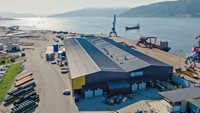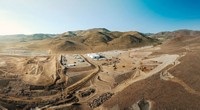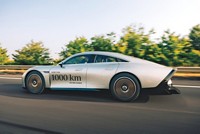Advertisement
Grab your lab coat. Let's get started
Welcome!
Welcome!
Create an account below to get 6 C&EN articles per month, receive newsletters and more - all free.
It seems this is your first time logging in online. Please enter the following information to continue.
As an ACS member you automatically get access to this site. All we need is few more details to create your reading experience.
Not you? Sign in with a different account.
Not you? Sign in with a different account.
ERROR 1
ERROR 1
ERROR 2
ERROR 2
ERROR 2
ERROR 2
ERROR 2
Password and Confirm password must match.
If you have an ACS member number, please enter it here so we can link this account to your membership. (optional)
ERROR 2
ACS values your privacy. By submitting your information, you are gaining access to C&EN and subscribing to our weekly newsletter. We use the information you provide to make your reading experience better, and we will never sell your data to third party members.
Business
Battery Boom
U.S. lithium-ion battery makers await transportation transformation
by Melody M. Bomgardner
February 6, 2012
| A version of this story appeared in
Volume 90, Issue 6

Sometimes wishes do come true. In early 2009, Barack Obama’s Administration wished for a U.S.-based advanced battery manufacturing industry, both to create jobs and to usher in a new age of electrified transportation. In his State of the Union address last month, President Obama took stock: “In three years, our partnership with the private sector has already positioned America to be the world’s leading manufacturer of high-tech batteries.”

That partnership included major grants to some firms from the Department of Energy as part of spending from the American Recovery & Reinvestment Act of 2009 (C&EN, July 27, 2009, page 24). Battery makers are now in position to power a new generation of electric vehicles; their factories are built or nearly completed. Yet they also find themselves uncomfortably out in front of their biggest customers—the automakers—and in need of other homes for their products while they wait for the coming electric vehicle revolution.
The rollout last year of the Chevy Volt and the Nissan Leaf, the first major-market cars to use lithium-ion batteries, was supposed to make 2011 a banner year for advanced batteries. However, slow sales—and safety concerns with the Volt battery—are leading many observers to question whether American consumers will ever adopt vehicles with the technology.
What’s clear is that leading U.S. battery manufacturers such as A123 Systems and Dow Kokam will be operating well below capacity for the near term. Battery maker Ener1 just filed for Chapter 11 bankruptcy. Its troubles began in early 2011 when a major automotive customer, Norway’s Think Global, stopped production.
David M. Pankratz, Dow Kokam’s vice president of operations, says it felt good to have President Obama single out the high-tech battery industry, but he adds that his company faces a tough road. “We’re not only a start-up company, but we are a start-up industry,” Pankratz says. “The challenges are magnified in a start-up industry with a whole new kind of technology.”
While they wait for the consumer auto market to gain ground, battery makers are taking an interest in smaller—but more immediate—destinations for their products, including fleet vehicles, stationary storage, and other niche applications. “The way to mitigate risk is to diversify your portfolio,” says Russell Hensley, a partner at the consulting firm McKinsey & Co. “In terms of early adoption you have the enthusiastic buyers and then the applications where it makes sense at battery costs today, like fleet vehicles that return to their charging base. As the costs of the batteries come down, then more applications make economic sense and you get increased adoption.”
For companies that successfully navigate the early years, the electric car era should eventually arrive and bring significant sales growth. The global market for large-format lithium-ion battery modules will expand to $47 billion in 2020 from an estimated $5 billion in 2010, an annual growth rate of 25%, according to technology market research firm ABI Research. In 2011, $1.1 billion worth of battery modules were sold in North America, says principal analyst David Alexander, and that figure will jump to $2.9 billion in 2012.
The first domestic lithium-ion battery maker out of the gate was A123 Systems. In 2009 the firm received $249 million in recovery act funds. A year later it opened a plant in Livonia, Mich., capable of producing 600 MWh of battery storage per year when fully operational.
In a conference call last month, A123 Systems’ chief financial officer, David Prystash, assured analysts that the company’s success does not depend on electric vehicles. Rather, he said, the firm is getting traction in stationary storage for the electric grid, for which it is the leading provider of lithium-ion batteries.
Dan Galves, a stock analyst at Deutsche Bank, applauded the strategy. In a note to investors, he said he expects A123 will bring in $350 million in sales of grid storage batteries between 2012 and 2014. In addition, A123’s batteries have found a small but growing market providing backup power for information technology systems and as replacements for lead-acid batteries in cell phone towers and other remote uses.
Still, A123 expects to get 50% of its revenues from transportation, says Andy Chu, head of marketing and communications. Even within that segment, the company sees several niches, including starter batteries and start-stop batteries.
Automakers are eyeing traditional 12-V lead-acid starter batteries in their quest to save weight and increase gas mileage, Chu explains. Replacing them with pricier but lighter lithium-ion batteries can help.
Using a lithium-ion start-stop battery takes that quest a step further by allowing the engine to stop running when a car is at a stoplight, for example. The battery can also get the car moving again before the combustion engine takes over.
Another important niche for A123 is fleet vehicles. By 2015 it expects to have a one-third share of the market for electric truck and bus batteries. Technology research firm Pike Research projects that 100,000 electrified trucks and buses will be sold annually by 2017. Though that’s much smaller than the passenger car market, the larger size of these commercial vehicles means they need many more battery cells.
“A Nissan Leaf has 20 kWh of battery cells, and our truck has 10 times that. We will be a much larger consumer as we scale up,” says Bryan Hansel, chief executive officer of Smith Electric Vehicles. Smith builds all-electric delivery trucks in the U.S. and the U.K. and is a customer of A123. Hansel says his company—and his industry—is a natural early adopter of electric drivetrain systems. The Smith Newton, a medium-duty truck, is already in its third generation.
Hansel wasn’t always an honored customer of the battery makers, however. “Let’s just say I wasn’t as graciously welcomed to battery factories in 2009. Everyone was chasing GM, Ford, Toyota. Everyone said they need giant contracts to justify the size of these factories,” Hansel recalls. “But now I’m much more welcomed because we generate purchase orders every month.”
Fleet operators choose electric not because they want the latest technology but because they expect a lower total cost of ownership over the long life of a delivery vehicle. Large diesel engines are getting more costly because of fuel cost increases and new emissions control regulations, Hansel points out.
The ramp-up of domestic battery production has put Hansel’s business in a fortunate position. “It’s tremendous for us that supply is coming up—we’re ahead of the demand curve and so we benefit from oversupply in the short term,” he says. “It drives down cost and helps drive demand for our products, and we can then be a bigger customer.”
A123 will get business from General Motors as well as Smith. In its early days, A123’s nanophosphate lithium-ion technology was in the running to power the Chevy Volt. GM, however, chose battery cells made by LG Chem, which the automaker forms into modules and packs at its own assembly plant. Nevertheless, A123 will provide battery modules for the all-electric Chevy Spark, a small city car that GM will introduce next year.
A123 will soon have competition. In mid-2012, Dow Kokam, a partnership of Dow Chemical and battery maker Kokam, will join the market with its own 400,000-sq-ft facility in Midland, Mich., capable of producing 600 MWh per year. “We’re working hard to balance the start-up schedule with demand,” Dow Kokam’s Pankratz says. “We’re staffing and training for about 25% of capacity, and we’re obviously anxious to ramp up as demand dictates.”
Like A123, Dow Kokam is targeting fleet vehicle, backup power supply, and stationary storage applications for the near term. Having to stay flexible has prevented the company from fully automating its assembly line. “The fact is, we don’t know what is needed yet—the industry is still defining what its needs are. We are staying focused on several markets,” Pankratz reports.

A third major Michigan plant is also scheduled to open in 2012. Johnson Controls-Saft, a joint venture between U.S. manufacturing firm Johnson Controls and French battery maker Saft, will make batteries in Holland, Mich. The facility was supported in part by a $299 million investment from the recovery act. One early destination for the plant’s batteries will be the Transit Connect, a small passenger bus made by Ford.
With so much production coming on-line, U.S. automakers will enjoy the luxury of buying batteries locally. In contrast, battery makers themselves are still importing most of their equipment and raw materials from Asia. “The raw materials side continues to be a challenge; our supply chain is long,” Pankratz complains. “As we come on-line we’re looking to qualify new suppliers in North America or have current suppliers move here. That is a transition that needs to continue.”
The anticipated growth in sales of electric vehicles will continue to attract new players globally, McKinsey’s Hensley says, even though “based on current projections, the capacity in place right now is sufficient to supply carmakers through the end of the decade.” When mass-market consumers will choose electric cars is the billion-dollar question, Hensley adds, but he has no doubt it will happen. “We’re still in the early days,” he says. “That will change quite quickly.”





Join the conversation
Contact the reporter
Submit a Letter to the Editor for publication
Engage with us on Twitter